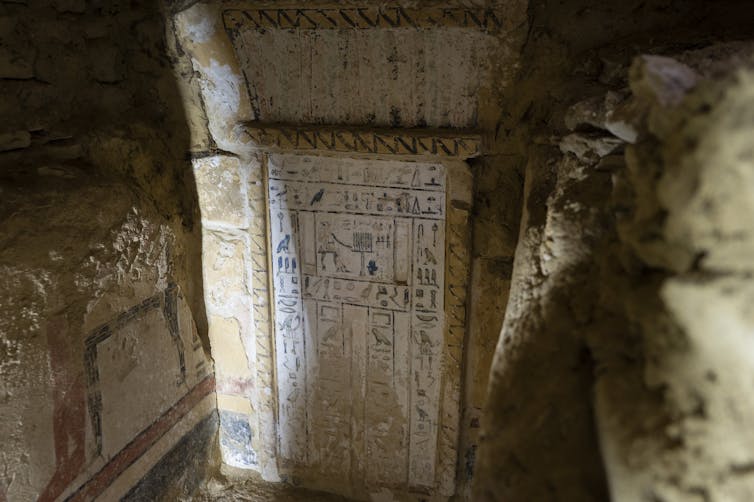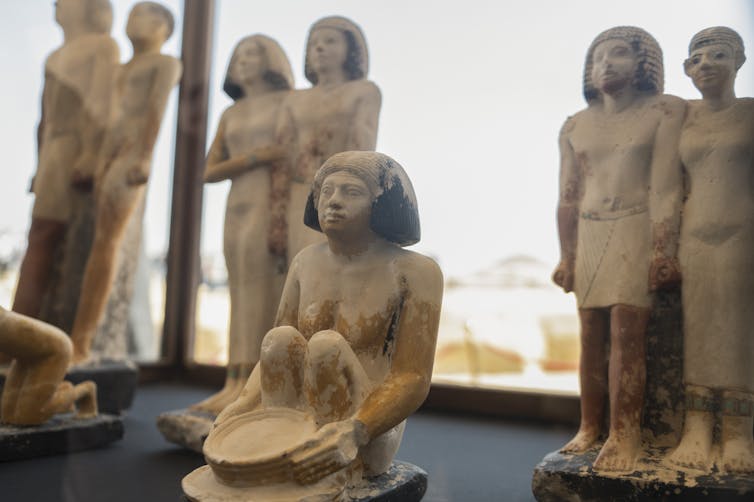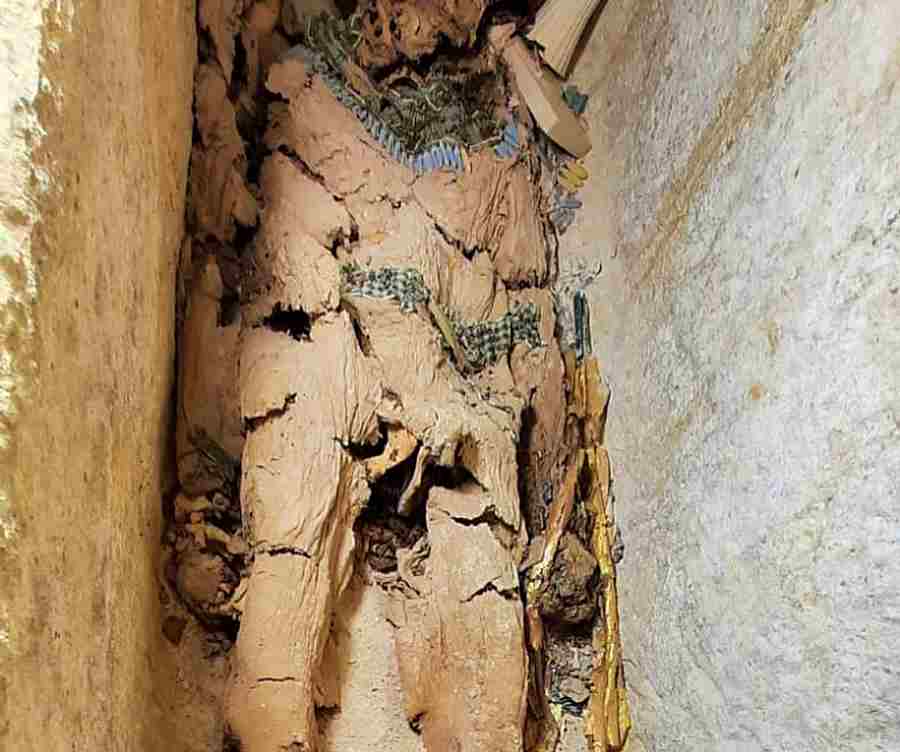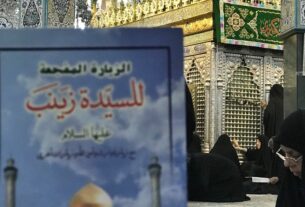![]() The mummy of Hekashepes is seen here. He was buried covered with gold leaf in ancient Egypt. (Image credit: Courtesy of the Egyptian Ministry of Tourism and Antiquities).
The mummy of Hekashepes is seen here. He was buried covered with gold leaf in ancient Egypt. (Image credit: Courtesy of the Egyptian Ministry of Tourism and Antiquities).
Thu 18 May 2023:
In January 2023, a group of archaeologists excavating tombs in the ancient necropolis of Saqqara, near Cairo, discovered the mummified remains of a man named Hekashepes, who lived circa 2300BC. Found inside a limestone sarcophagus in a burial shaft, the body and its wrappings are unusually well preserved for the period.
In the 5th century BC, the Greek historian Herodotus of Halicarnassus described the elaborate way Egyptians preserved their dead. The brain was removed through the nostrils with a hook, while the inner organs were removed through a cut in the abdomen.
The cut was then stitched up and the body rinsed with wine and spices. The body was left to dry in a natron solution (a substance harvested from dry lake beds and used to absorb moisture) for up to 70 days. After this period, it was carefully wrapped in linen bandages and finally laid to rest inside a coffin.
By the time Herodotus wrote this, Egyptians had been practising mummification for more than two millennia, gradually perfecting the technique through experimentation.
The pre-dynastic mummies of the fourth millennium BC were so well preserved by the dry desert sands – without human intervention – that their tattoos are still visible. The earliest attempts to replicate this outcome by artificial means were less effective so Hekashepes represents an early example of successful preservation.
Why did ancient Egyptians mummify their dead?
Egyptians had long observed that bodies interred in graves without direct contact with the drying sands tended to decompose and sought to prevent this for religious reasons.
Without a physical body to which it could return, they believed the Ka (soul essence) could not partake in food offerings brought to the cemetery and was instead left to roam the world of the living as a harmful spirit.
Mummification techniques were developed in order to preserve the body for the Ka. The earliest methods, which emerged no later than the time of state unification circa 3100BC, involved wrapping the body with resin-soaked linen bandages. However, as the intestines were left in place, the body eventually decomposed.

A general view inside one of the tombs recently discovered in Saqqara, including that of Hekashepes. Mohamed Hossam Eldin
The lack of preserved human remains from this early period means that archaeologists have limited data on demographics, population health, life expectancy and diet. For this reason, the discovery of Hekashepes’ remains is highly significant.
Scientific examination of the body will provide important insight into the mummification techniques used. Scientific analysis of the skeleton and teeth might also shed light on where Hekashepes grew up, what kind of food he ate, his health, his age and the cause of his death.
How was Hekashepes preserved?
Hekashepes’ arms and legs had been individually wrapped to give the body a life-like appearance, and the head was painted with eyes, a mouth and dark hair. More striking, however, are the gold leaves that had been carefully applied to give the illusion of golden skin.
According to Egyptian beliefs, gold was the colour of the gods, and gilding the bodies of the dead expressed the idea that they acquired divine qualities in the afterlife.
As such, Hekashepes’ loved ones could take comfort in knowing that he would be reborn and rejuvenated in the afterlife, enjoying his favourite food and drink with the gods for all eternity.
What does the discovery teach us?
The archaeologists who uncovered Hekashepes’ sarcophagus also discovered, in a nearby tomb, a group of well-preserved limestone statues depicting men, women and children. These images, which only the wealthy could afford, were made to accompany burials as “reserve bodies” for the Ka to inhabit.
The beautiful statues, on which paint is still visible, depict men with athletic bodies and reddish-brown skin. The women are curvy and pale. Both sexes are depicted with luscious dark hair.
The images reflect gender roles in which men took on active roles in the public sphere, while women stayed indoors and looked after the home. Some of the statues depict women engaged in domestic tasks like grinding grain and baking bread, demonstrating the importance placed on women’s labour in the household.
The statues of married couples depict the husbands and wives affectionately linking arms. Some are shown with their children standing or kneeling by their feet.
The images of married couples and families emphasise the importance of the family as the basic social unit in ancient Egyptian society. Kinship ties were maintained in death and the living had an obligation to provide food offerings to sustain their relatives in the afterlife.

Statues displayed after the announcement of the discoveries in Saqqara, including couples holding hands. Mohamed Hossam Eldin
The Egyptians believed that, in return for the offerings, the dead could be called on for assistance. They could also act as intermediaries between the living and Osiris, the divine ruler of the underworld.
Although it is easy to get the impression that the ancient Egyptians were obsessed with death, the care with which they treated their dead reveals a love for life and a sincere hope of continued existence after death.
The discovery of Hekashepes’ body gives us hope that more well-preserved human remains from the period will come to light and increase our understanding of life in the age of the pyramids.
![]()
Maiken Mosleth King
Lecturer in Ancient History, University of Bristol
My PhD research, supervised by Dr Shelley Hales and Dr Silke Knippschild, centres on Egyptian funerary stelae from the Roman period, using the site of Terenouthis/Kom Abou Billou as a case study. I am exploring how the inscriptions and iconography are used to construct and express the social identity of the deceased, with particular focus on gender, religious identity and ethnic identity; I am also investigating the effects of linguistic interference from the Egyptian language on the Greek language in Terenouthis.
I have previously completed a BA and MA in Egyptology at the University of Liverpool, where I specialised in the ancient Egyptian language and literary texts. My BA thesis investigated the concept of divine kingship in didactic literature from the Middle Kingdom period. My MA thesis, supervised by Dr Roland Enmarch and Prof Christopher Eyre, focused on the themes and motifs in the Late Egyptian literary text ‘Tale of Two Brothers’.
My research interests are diverse and include ancient Egyptian language and literature, cross-cultural contact in the ancient Near East and Mediterranean, language contact in the eastern Mediterranean and Near East, Hellenism and Greek language in Egypt and the Near East, comparative Semitic philology, religion in ancient Egypt and the Mediterranean, Coptic language and literature, early Christianity, the reception of ancient Egypt and archaeology in modern visual media, and the reception of ancient Egypt in 19th and 20th century spirituality and religious movements.
My linguistic competence is broad and includes Egyptian hieroglyphs, Coptic, Classical Greek, Latin, Biblical Hebrew, Phoenician and Classical Arabic.
In addition to my academic research I am actively involved in the outreach programmes Access to Bristol and Classics for All, delivering workshops to schools in the South on a wide range of topics related to the study of ancient Egypt, Greece and Rome. I also regularly teach courses in ancient Egyptian hieroglyphics and give public lectures on a range of topics related to Egyptology and ancient history. For upcoming events and courses, please visit https://mmkingevents.weebly.com and https://kemetklub.co.uk.
I am on the board of the Friends of the Petrie Museum, UCL as Secretary-Treasurer. In addition to this role I am also on the judging panel for the category Classical Studies and Archaeology of the Global Undergraduate Awards, an academic awards programme which aims to connect undergraduate students across national borders and academic disciplines.
This Article Originally Published in The Conversation Click Here
______________________________________________________________
FOLLOW INDEPENDENT PRESS:
TWITTER (CLICK HERE)
https://twitter.com/IpIndependent
FACEBOOK (CLICK HERE)
https://web.facebook.com/ipindependent
Think your friends would be interested? Share this story!





